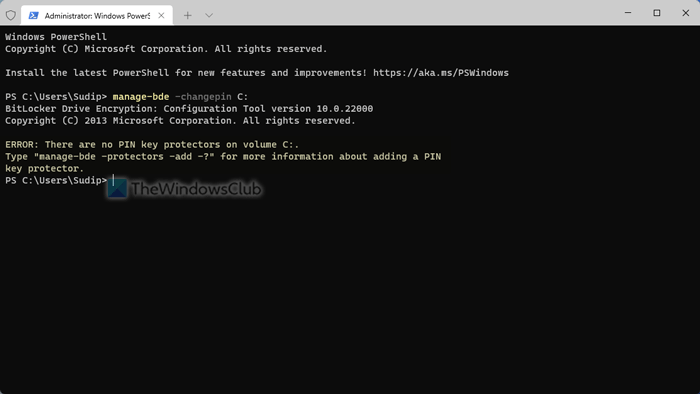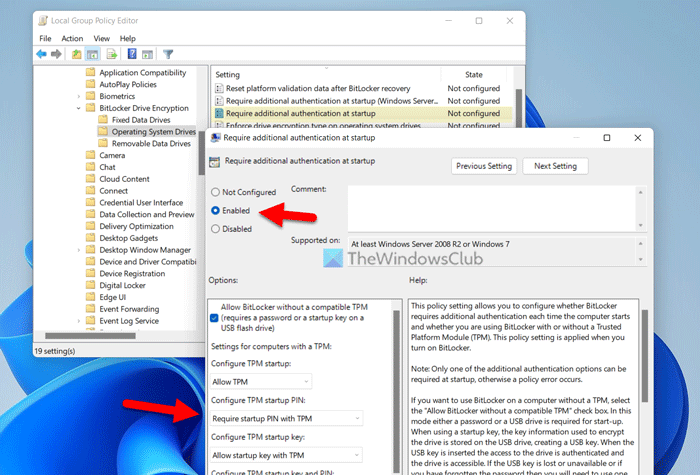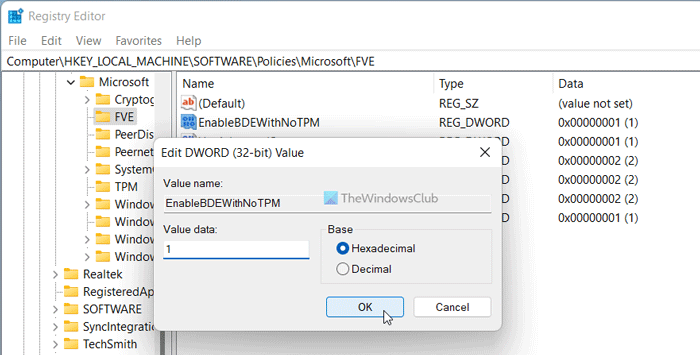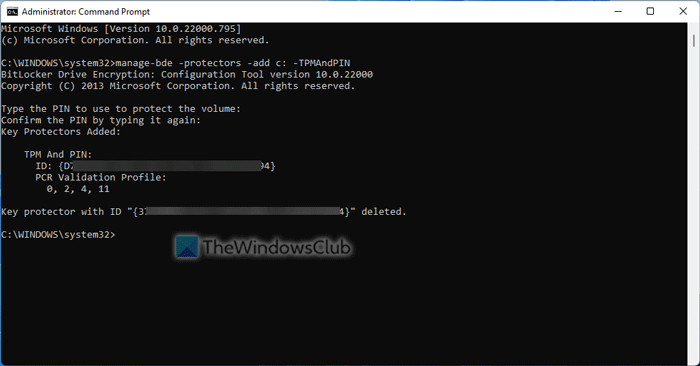When changing the BitLocker password or PIN, if you get There are no PIN key protectors on volume C error in Command Prompt, Windows PowerShell, or Windows Terminal, here is how you can get rid of this issue. It appears when you haven’t set a PIN for the protected drive and tried changing the PIN using Command Prompt or any other command-line utility.

The entire error message says:
ERROR: There are no PIN key protectors on volume C:.
Type “manage-bde -protectors -add -?” for more information about adding a PIN key protector.
In order to fix this problem, you need to create a PIN for the BitLocker-protected drive on Windows 11 or Windows 10. There are mainly two steps you need to go through. First, you must enable the PIN requisition using Local Group Policy Editor. Second, you need to use Command Prompt, Windows PowerShell, or Windows Terminal to set the PIN.
There are no PIN key protectors on volume C
To fix There are no PIN key protectors on volume C on Windows 11/10, follow these suggestions:
- Setup PIN requisition at startup
- Setup PIN using Command Prompt or PowerShell
To learn more about these steps, continue reading.
1] Setup PIN requisition at startup
To fix this issue, you need to set up PIN requisition at the startup. It helps you enable the TPM startup PIN, which is directly involved with this error. That is why you can use either the Local Group Policy Editor or the Registry Editor to set up PIN authentication at the startup.
Using Local Group Policy Editor:
Press Win+R to open the Run prompt. Then, type gpedit.msc and hit the Enter button.
Once the Local Group Policy Editor is opened on your computer, follow this path:
Computer Configuration > Administrative Templates > Windows Components > BitLocker Drive Encryption > operating System Drives
Here you can find a setting called Require additional authentication at startup. You need to double-click on this setting and choose the Enabled option.

Then, expand the Configure TPM startup PIN drop-down list and choose the Require startup PIN with TPM option.
Finally, click the OK button to save the change.
Using Registry Editor:
First, press Win+R > type regedit > click the OK button and click on the Yes option on the UAC prompt to open the Registry Editor.
Then, navigate to this path:
HKEY_LOCAL_MACHINE\SOFTWARE\Policies\Microsoft
Right-click on Microsoft > New > Key and name it FVE. Then, you need to create six REG_DWORD values.
For that, right-click on FVE > New > DWORD (32-bit) Value.

Name them as:
- EnableBDEWithNoTPM: 1
- UseAdvancedStartup: 1
- UseTPM: 2
- UseTPMKey: 2
- UseTPMKeyPIN: 2
- UseTPMPIN: 1

Following that, set the Value data as mentioned above. For that, double-click on each REG_DWORD value and set the Value data accordingly.
Finally, close all windows and restart your computer.
2] Setup PIN using Command Prompt or PowerShell
Once you are done with the PIN authentication setting at the startup using GPEDIT or REGEDIT, you can use the Command Prompt or Windows PowerShell to set up the PIN. Alternatively, you can use Windows Terminal as well. Either way, you need to open those apps with administrator privilege.
To open Command Prompt with administrator permission, search for cmd in the Taskbar search box, click on the Run as administrator option and click the Yes option on the UAC prompt.
To open Windows PowerShell with administrator permission, search for powershell in the Taskbar search box, click on the Run as administrator option and choose the Yes option on the UAC prompt.
Once the elevated window is opened, enter this command:
manage-bde -protectors -add c: -TPMAndPIN
Next, you need to type the PIN twice for confirmation.

Once done, you can use the new PIN without any error.
Read: How to Turn On or Off the use of BitLocker on Removable Data Drives
How do I enable BitLocker for C drive?
To enable BitLocker for C drive or system drive, you need to open the Control Panel first. Then, click on the BitLocker Drive Encryption option. Here you can find the C drive. You need to click on the Turn on BitLocker option and choose an option to back up the recovery key. Following that, you can find an option to encrypt only used space or the entire disk. Finally, you can see a button called Start encrypting. Click on this button to turn on BitLocker for the C drive.
Where is my BitLocker PIN?
BitLocker stores the PIN in different locations according to your requirements. For example, you can store the PIN or recovery key in your Microsoft account, USB flash drive, local storage, or print the key. You can find all these options when you set BitLocker up on your computer to password protect a drive. For your information, you need to choose an option wisely as it is required when you forget the PIN.
That’s all! Hope this guide helped.
Read: Choose how BitLocker unlocks OS Drive at Startup in Windows.
Leave a Reply